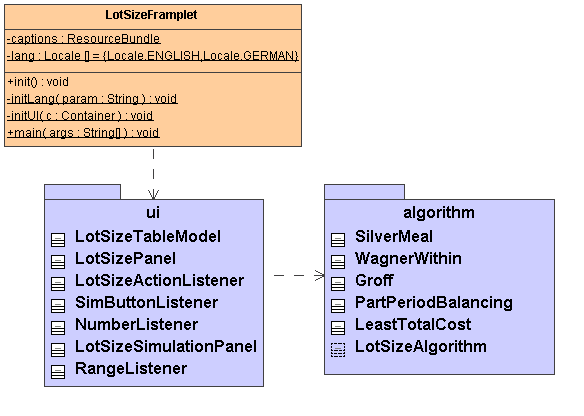|
Homepage
|
Overview
- run the applet
- How to use the applet
- business background
- technical background
- The Applet in Learning Environments
|
[top] |
How to use the Applet
The Applet offers different algorithms for computing the optimal size of an order or a lot.
In the upper part of the interface the holding costs, setup costs, the planning horizon, and the algorithm can be specified. In the table below the demand for each period can be added. After pushing the button Compute, the lot size is computed using the data given.
|
[top] |
Business Background
MRP II systems in Operations Management use tools to compute the optimal size of orders or lots. Beside the classic static model (Economic Order Quantity), dynamic models are used. In dynamic models the lot size may vary across the planning periods. These models strive to solve the problem of finding the set of lot sizes that will “cover” the demand over the time horizon and will minimize the sum of the relevant costs. The demand for each period is assumed to be an integer number.
The relevant costs can be divided into two major categories. The inventory holding cost - the cost of holding the manufacttured or purchased material in stock increase as the lot size or order size increases. The cost of obtaining that material and the cost for setting up the machines do not change with the size of the lot or the order. However, these fixed cost may be variable costs related to another cost driver. The direct costs for manufacturing are not relevant because they would be incurred irrespective of the batch size.
The basic idea of the heuristic models is taken from the properties of the Economic Order Quantity: the minimum of the costs can be found where the holding costs for a batch match the setup costs for a batch. The heuristics iteratively add the demand for a period until a criterion is reached which is a bit different for each heuristic.
- Wagner-Within algorithm
- always finds the optimal solution using dynamic programming, this is not a heuristic
- Least Total Cost
- stop when the holding cost for the produced batch becomes larger then the setup costs.
- Part-Period-Balancing
- choose a run for which setup and holding costs are balanced as far as possible
- Silver Meal heuristic
- stop when the total variable cost per unit time reaches a minimum
- Groff-heuristics (least unit cost heuristic)
- stop when the total variable cost per unit of demand reaches a minimum
|
[top] |
Technical Background
Since all these models are based on the same data - the order costs, the
storage costs and the demand over a fixed number of periods - it is possible to
define an abstract base class (LotSizeAlgorithm). The derived classes implement the different
computation strategies described above. It is possible to switch between the
different models, also. These aspects are modeled in the UML dagram below:
In the UML-diagram below the structure of the applet is
shown. The package ui contains all classes of the user interface.
In the package algorithm the classes can be found which implement
the algorithms for computing the lot size. The UML diagrams for these packages
are reachable via the package symbols in the diagram below.

|
[top] |
The Applet in Learning Environments
Recently learning environments and E-Learning has received a lot of interest. This applet is meant as a contribution, to help understanding the complex algorithms for computing the lot size. Running single computations can be compared with computations by hand. The simulations point out the quality of the heuristics compared to the Wagner-Within algorithm.
Interest on these applets has been shown by universities. Possibly these applets will be used to support learning environments or to support lectures:
- As part of the Swiss Virtual Campus in the sub project OPESS (Operations Management, ERP and SCM Systems). The research group of Prof. Knolmayer sustantially extended and improved the applet.
- At the chair of Professor Hoitsch at the University of Mannheim
I would be glad to cooperate with projects dealing with this topic.